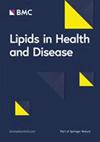残余胆固醇对高血压心力衰竭患者左心室肥厚和预后的预测价值:一项前瞻性研究
IF 3.9
2区 医学
Q2 BIOCHEMISTRY & MOLECULAR BIOLOGY
引用次数: 0
摘要
残余胆固醇(RC)与心脏病患者的不良预后密切相关。同时患有高血压和心力衰竭(HF)的患者通常会出现左心室肥厚(LVH),预后较差。本研究调查了基线 RC 水平、左心室重塑和患者的预后。从2018年10月至2020年8月,连续630名高血压和HF患者参加了这项前瞻性试验。根据左心室质量指数(LVMI),符合条件的560人被分为LVH组和非LVH组。多元线性回归和接收器操作特征曲线(ROC)检验了 RC 和 LV 的关系。还进行了 Cox 回归分析,以检验 RC 对临床结果的预测价值。LVH 组的 RC、甘油三酯和胆固醇值明显升高,而高密度脂蛋白胆固醇 (HDLC) 则明显下降。预测左心室重构的 RC 最佳临界值为 0.49。受试者的观察期中位数为 58 个月,其中 104 人达到了主要终点。对涉及两个 Cox 模型的风险模型进行了调整,以纳入混杂因素,结果显示,RC 基线水平升高的受试者更容易发生心血管死亡,这表现为危险比升高。(HR:1.91,95% CI:1.62-2.26 vs. HR:1.75,95% CI:1.43-2.16,P <0.001)。RC与高血压性心房颤动患者的左心室重塑有关,左心室肥厚患者的RC值更大。此外,RC值越高的高血压心房颤动患者心血管死亡风险越高。NCT 03727828,2018年10月21日。本文章由计算机程序翻译,如有差异,请以英文原文为准。
Predictive value of remnant cholesterol for left ventricular hypertrophy and prognosis in hypertensive patients with heart failure: a prospective study
Remnant cholesterol (RC) is substantially related to negative outcomes in cardiac patients. Patients with coexisting hypertension and heart failure (HF) often develop left ventricular hypertrophy (LVH) and have poor prognoses. This study investigated baseline RC levels and LV remodelling and patients’ prognoses. Six hundred thirty consecutive individuals with hypertension and HF participated in this prospective trial from October 2018 to August 2020. Based on left ventricular mass index (LVMI), 560 those eligible were separated into LVH and non-LVH groups. Multiple linear regression and receiver operating characteristic (ROC) curves examined the RC and LV relationship. A Cox regression analysis was conducted to examine the predictive value of RC for clinical outcomes. The LVH group presented significantly elevated values of RC, triglyceride, and cholesterol and decreased high-density lipoprotein cholesterol (HDLC). The optimal cutoff value for RC to predict LV remodelling was 0.49. The subjects were observed for a median of 58 months, and 104 participants met the primary endpoint. The risk models involving the two Cox models were adjusted to incorporate confounding factors, which revealed that those with elevated baseline levels of RC were more susceptible to cardiovascular mortality, as shown by an increased hazard ratio. (HR: 1.91, 95% CI: 1.62–2.26 vs. HR: 1.75, 95% CI: 1.43–2.16, P < 0.001). RC is linked to LV remodelling in patients with hypertensive HF, with LVH having greater RC values. Moreover, patients with hypertensive HF who had a higher RC suffered from an increased risk of cardiovascular mortality. NCT 03727828, 21 Oct 2018.
求助全文
通过发布文献求助,成功后即可免费获取论文全文。
去求助
来源期刊

Lipids in Health and Disease
生物-生化与分子生物学
CiteScore
7.70
自引率
2.20%
发文量
122
审稿时长
3-8 weeks
期刊介绍:
Lipids in Health and Disease is an open access, peer-reviewed, journal that publishes articles on all aspects of lipids: their biochemistry, pharmacology, toxicology, role in health and disease, and the synthesis of new lipid compounds.
Lipids in Health and Disease is aimed at all scientists, health professionals and physicians interested in the area of lipids. Lipids are defined here in their broadest sense, to include: cholesterol, essential fatty acids, saturated fatty acids, phospholipids, inositol lipids, second messenger lipids, enzymes and synthetic machinery that is involved in the metabolism of various lipids in the cells and tissues, and also various aspects of lipid transport, etc. In addition, the journal also publishes research that investigates and defines the role of lipids in various physiological processes, pathology and disease. In particular, the journal aims to bridge the gap between the bench and the clinic by publishing articles that are particularly relevant to human diseases and the role of lipids in the management of various diseases.
 求助内容:
求助内容: 应助结果提醒方式:
应助结果提醒方式:


